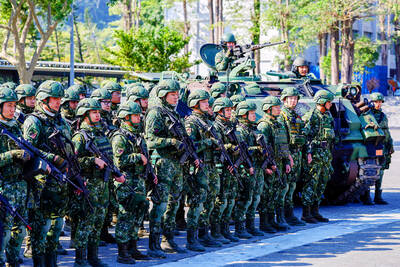A tail rotor failure might have caused a Taiwanese Navy S-70C anti-submarine helicopter to crash in Kaohsiung during a training mission on Wednesday, a preliminary inquiry has shown.
The aircraft “made a hard landing” on the tarmac of the Kaohsiung Zuoying naval base on Wednesday at about 4pm, injuring all four crew members, with one in critical condition, navy Chief of Staff Vice Admiral Chiang Cheng-kuo (蔣正國) said at a news conference yesterday.
Accounts from air traffic controllers and the helicopter’s pilots pointed to a tail rotor failure, Chiang said, adding that no other mechanical problems were encountered before the incident.

Photo: CNA
An official cause of the crash has not been determined pending investigation, he said.
The crew chief, surnamed Liu (劉), suffered the most severe injuries and is in hospital in critical condition, Ministry of National Defense Medical Affairs Bureau official Chen Yuan-hao (陳元皓) said.
Liu sustained second and third-degree burns on 95 percent of his body, and has a subarachnoid hemorrhage — bleeding between the brain and its surrounding membrane, Chen said.
The other crew members are in stable condition after being treated at a military hospital in Kaohsiung, including a chief inspector surnamed Kuo (郭), who has second and third-degree burns on 20 percent of his body, Chen said.
The pilot, surnamed Chen (陳), and co-pilot, surnamed Cheng (鄭), have relatively minor injuries, such as rib fractures and lacerations to the face and limbs, he said.
The navy said the helicopter was severely damaged, and it would assess whether repair is possible.
The crash was the fourth military aircraft accident this year, following crashes of an F-16 fighter, a Mirage 2000 fighter and an AT-3 trainer, resulting in the deaths of two pilots.
Taiwan’s Naval Antisubmarine Aviation Group has 18 S-70Cs, which have been in service since 1991, including the one that crashed on Wednesday.
Three other S-70C-related incidents that resulted in severe damage to the aircraft occurred in 1994, 2005 and 2008.

UNILATERAL MOVES: Officials have raised concerns that Beijing could try to exert economic control over Kinmen in a key development plan next year The Civil Aviation Administration (CAA) yesterday said that China has so far failed to provide any information about a new airport expected to open next year that is less than 10km from a Taiwanese airport, raising flight safety concerns. Xiamen Xiangan International Airport is only about 3km at its closest point from the islands in Kinmen County — the scene of on-off fighting during the Cold War — and construction work can be seen and heard clearly from the Taiwan side. In a written statement sent to Reuters, the CAA said that airports close to each other need detailed advanced

Tropical Storm Fung-Wong would likely strengthen into a typhoon later today as it continues moving westward across the Pacific before heading in Taiwan’s direction next week, the Central Weather Administration (CWA) said. As of 8am, Fung-Wong was about 2,190km east-southeast of Cape Oluanpi (鵝鑾鼻), Taiwan’s southernmost point, moving westward at 25kph and possibly accelerating to 31kph, CWA data showed. The tropical storm is currently over waters east of the Philippines and still far from Taiwan, CWA forecaster Tseng Chao-cheng (曾昭誠) said, adding that it could likely strengthen into a typhoon later in the day. It is forecast to reach the South China Sea

WEATHER Typhoon forming: CWA A tropical depression is expected to form into a typhoon as early as today, the Central Weather Administration (CWA) said yesterday, adding that the storm’s path remains uncertain. Before the weekend, it would move toward the Philippines, the agency said. Some time around Monday next week, it might reach a turning point, either veering north toward waters east of Taiwan or continuing westward across the Philippines, the CWA said. Meanwhile, the eye of Typhoon Kalmaegi was 1,310km south-southeast of Oluanpi (鵝鑾鼻), Taiwan’s southernmost point, as of 2am yesterday, it said. The storm is forecast to move through central

Almost a quarter of volunteer soldiers who signed up from 2021 to last year have sought early discharge, the Legislative Yuan’s Budget Center said in a report. The report said that 12,884 of 52,674 people who volunteered in the period had sought an early exit from the military, returning NT$895.96 million (US$28.86 million) to the government. In 2021, there was a 105.34 percent rise in the volunteer recruitment rate, but the number has steadily declined since then, missing recruitment targets, the Chinese-language United Daily News said, citing the report. In 2021, only 521 volunteers dropped out of the military, the report said, citing